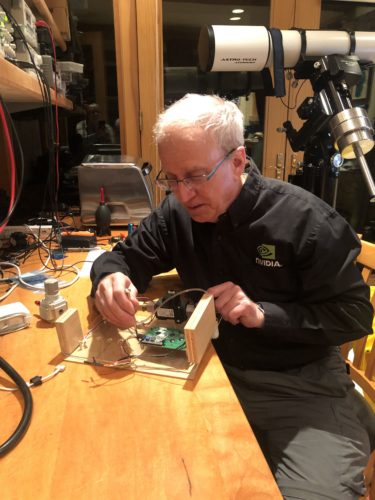NVIDIA Chief Scientist Bill Dally this week released an open-source design for a low-cost, easy-to-assemble mechanical ventilator.
The ventilator, designed in just a few weeks by Dally — whose storied technology career includes key contributions to semiconductors and supercomputers — can be built quickly from just $400 of off-the-shelf parts, Dally says.
Traditional ventilators, by contrast, can cost more than $20,000 — and that’s when the world hasn’t been slammed with demand for the life-saving machines.
“I hope that we don’t get so many people sick that we run out of ventilators,” Dally says, speaking from a spartan home electronics workshop stocked with oscilloscopes, voltmeters and other lab equipment.
“But I want to make sure if we do, something like this is ready,” he adds.
Ventilators and Coronavirus
Ventilators, of course, are urgently needed around the world to address the medical crisis that has gripped the globe.
Of patients that are infected with COVID-19, between 0.3 percent and 0.6 percent develop acute respiratory distress syndrome severe enough to need a mechanical ventilator, Dally explains.
Dally’s aim was to build the “simplest possible” ventilator.
His ventilator is built around just two easily sourced, key components – a proportional solenoid valve and a microcontroller to regulate the flow of gas through the valve to the patient.
Dally holds more than 120 patents. He’s had teaching and research stints at Caltech, MIT and Stanford, where he chaired the computer science department.
He’s led NVIDIA’s research team since 2009. It includes more than 200 scientists from around the globe focused on areas such as AI, computer vision, self-driving cars, robotics and graphics.
Dally began exploring how to make a contribution after NVIDIA CEO Jensen Huang called on company leaders to look for ways to help with the COVID-19 pandemic.
Dally quickly connected on phone calls and in video conferences with leaders across the technology and medical fields.
NVIDIA CEO: “It Works!”
Then, when kayaking on the cool, crystal-clear waters of Lake Tahoe in early April, where he was sheltering in place, inspiration struck.

Dally went online and ordered a solenoid valve, which uses an electromagnet to squeeze a valve open and shut.
Then he pulled the microcontroller, a cheap, stripped-down computer, out of the home-brewed cooling system he’d built for his wine cellar.
After pulling a couple of late nighters in his home electronics workshop — and cranking out several thousand lines of code — Dally had a working prototype built from common pipe fittings and a few easily obtained valves.
On April 4 Dally shared a video, shot in his garage by his wife, of the device slowly inflating and deflating a rubber glove, with his NVIDIA colleagues.
Jensen’s reaction: “It works!”
Gathering Expert Advice
To continue moving the project forward, Dally dipped into the expertise of contacts across a wide range of disciplines.
He turned to Paul Karplus, a former student, noted for his work in autonomous vehicles and robotics, for the mechanical engineering of key parts.
He also relied on Emma Tran, a fourth-year medical student, to make a number of other connections in the medical field.
Dally quickly gathered input from Dr. Andrew Moore, a chief resident at the Stanford University School of Medicine, Dr. Bryant Lin, a prominent medical devices expert and founder of two companies, and anesthesiologist Dr. Ruth Fanning.
Dally turned to Dr. David Gaba a top expert in immersive and simulation-based learning, to test the device’s capabilities.
On Friday, April 17, Dr. Gaba tested a prototype on a sophisticated lung simulator, modeling normal and two levels of COVID-19 lung disease with a wide variety of ventilator settings.
It worked as expected, Dally reports.
Read NVIDIA Chief Scientist Bill Dally’s paper detailing his open-source design for a low-cost, easy-to-assemble ventilator.
From Parts to Functional Ventilator in 5 Minutes
Yet the latest prototype of Dally’s device, which he assembled in his home workshop, remains simple and reliable.
Dally reports he can bolt the device’s pneumatic components together in 5 minutes. The entire ventilator can be attached to a simple display and slid into a compact Pelican carrying case.
It provides better care than “bag squeezer” emergency ventilators because it precisely regulates flow, pressure, and volume, Dally says. It also uses fewer parts and less power, and it’s lower cost.
It includes sensors that accurately meter airflow, compensate for valve inaccuracy, control maximum pressure, enable patient-initiated breathing, and monitor for alarm conditions, among other features.
Dally’s now in the process of navigating the paperwork needed for emergency use authorization from the U.S. Food and Drug Administration.
After that, the next step will be to find a way to start building these.
To learn more about innovative projects like this, visit Research at NVIDIA.
